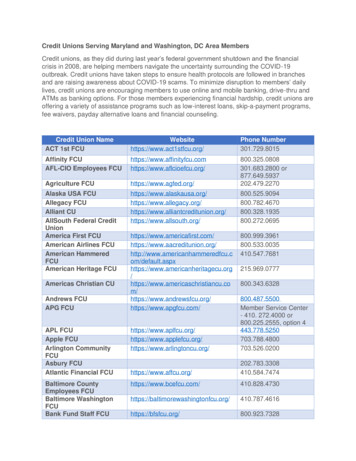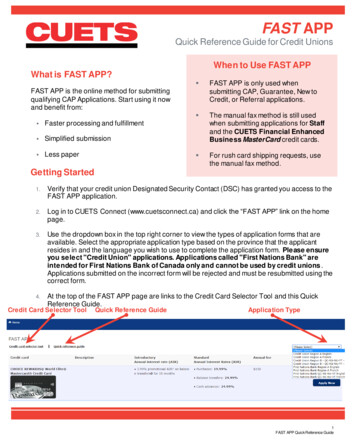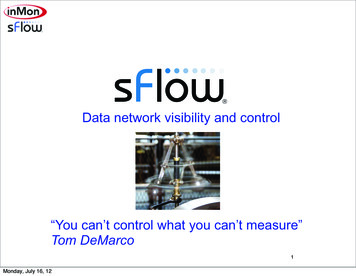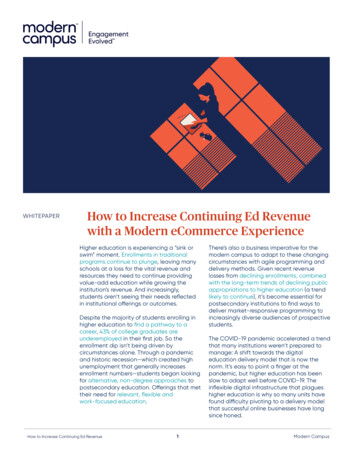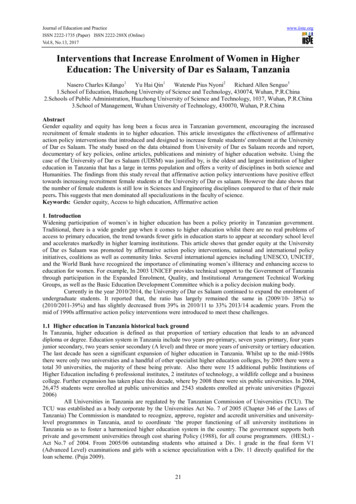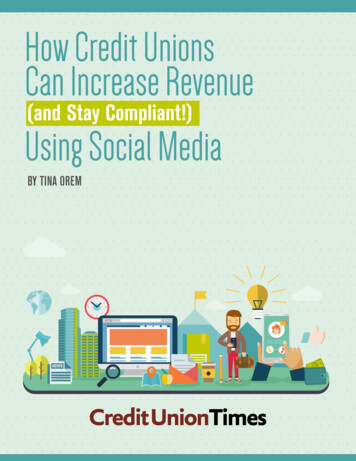
Transcription
How Credit UnionsCan Increase Revenue(and Stay Compliant!)Using Social MediaBY TINA OREM
Social media is a powerful tool, but for many credit unions it’slittle more than a once-in-a-while chore on a long list of otherwork to do. And, it doesn’t always seem to generate much in theway of revenue.Some credit union social media experts, however, are shattering that perception. They have changed how they think aboutsocial media’s purpose, and they have turned it into a tool thatdoes more than just connect with members: It generates sales.Regulations regarding social media are evolving, too. In orderto protect lucrative new social media programs, credit unionsneed to understand the essentials of maintaining regulatorycompliance.This case study explores how the 766 million Oshkosh, Wis.based Verve, a Credit Union, turned its social media program intoa revenue engine while keeping its social media activities in linewith today’s regulatory requirements.About Verve and Chatter Yak!Headquartered in Oshkosh, Wis., Verve, A Credit Unionis open to anyone who lives, works or worships in severalcounties in Wisconsin and Minnesota. Membership is alsoopen to employees of Kimberly-Clark, Neenah Paperand the medical servicesindustry and immediate family members of any currentmember. It has 766 millionin assets, 15 branches and56,000 members.Chatter Yak! is a CUSOco-owned by Verve, A CreditUnion that was establishedin June 2011 in Sandusky,Ohio. It provides loan-generating and member-generationsoftware, marketing and consulting services and marketingcampaigns rooted in social media. It also helps credit unionsand community banks capitalize on social media data.BACKGROUNDThe social media story of Verve, A Credit Union really begins withthe birth of a CUSO called Chatter Yak!, which was co-foundedin 2011 by Bryce Roth, Verve’s former director of cooperativeoutreach, and Kevin Ralofsky, who is Verve’s current presidentand CEO.“We started the CUSO for a number of reasons. One, we’revery firm believers in the cooperative principles and cooperationamong cooperatives,” Roth explained. “We started realizing wewere doing things that were working and that made sense forthe credit union and for our members, and that it would be sillyin light of the cooperative principles to keep those to ourselves.But at the same time, we were also out there looking at all theseother tools and resources that we could use if we had a budget.”The CUSO specializes in helping credit unions and communitybanks capitalize on social media. After its formation, Chatter Yak!launched Yak Tracker, an application that helps credit unionsgrow its social media presence via sweepstakes, trivia and contests on Facebook, Twitter, YouTube or other platforms.The application collects detailed information from entrantsthat credit unions can then use to do more than just connect.Credit unions can use it to advance existing or potential membersthrough the purchase funnel to loans, new accounts or otherproducts.In 2015, Verve used the method to add 175 new loans linkeddirectly to its use of social media. It also generated additionalnoninterest income from 52 GAP policies and 68 debt-cancelation policies that came through social media, according to thecredit union. In total, it added 2.5 million to its loan portfolio.Its goal in 2016: 4 million.Karrie DrobnickKarrie Drobnick is the chief marketing officer for Verve, aCredit Union. Using her vast experience and passion fordigital marketing, she and her team created an excitingbrand that has engaged the communities they serve. Asthe CMO, Karrie is responsible for both the strategic direction of marketing and technology. Prior to joining the creditunion in 2014, she was director of interactive strategy anddevelopment for Ameriprise Auto and Home Insurance; shealso has substantial experience as an account strategistand corporate communications manager.Drobnick175 NEw Loans 2.5 MillionBryce RothBryce Roth is a strategic marketing and public relationsexpert, public speaker and consultant with extensiveexperience working on new media platforms, and a passionfor credit unions. He is co-founder and president of ChatterYak!, a CUSO of Verve, A Credit Union. Prior to launchingthe social media startup, Roth was director of cooperativeoutreach at Verve. He also served as marketing coordinatorfor Vacationland FCU. Some of his professional awardsinclude the CU Times Trailblazer 40 Below, CUES NextTop Credit Union Executive finalist and CUNA 2014 CreditUnion Rockstar.2Social Income216 Goal 4 million in new loansRoth52 New GAP insurance policies68 new debt-cancelation policies How Credit Unions Can Increase Revenue (and Stay Compliant!) Using Social Media
Climbing the social ladderFour years ago, when Roth joined Verve, A Credit Union, it hadno real social media presence. Today, Verve’s heft in the socialmedia world is substantial.The credit union now ranks No. 54 on The Financial Brand’sPower 100 list of “Top 100 Credit Unions Using Social Media,”pulling in more than 13,000 Facebook “likes,” 800-plus Twitterfollowers and nearly 196,000 views on YouTube. That gives itmore social media sway than some credit unions on the list thatare several times Verve’s size — behemoths such as 2.4 billionEl Paso, Texas-based GECU, which has 348,000 members andranked 61st on the list; Bethpage, N.Y.-based Bethpage FCU,which has almost 7 billion in assets and more than 293,000members (it ranked 73rd); and even 7.3 billion Live Oak, Texasbased Randolph-Brooks FCU, which has 657,000 members andranked 55th.“This is another vehicle that represents your credit union. Ifwe’re really going to talk to generations today and in years tocome, we have to figure out all sorts of different media,” Verve, ACredit Union’s Chief Marketing Officer Karrie Drobnick explained.Today, Verve uses the following social media mYouTubeWhat counts as social media?Social media is changing all the time, and in some cases its definition is a matter of opinion. One opinion about what social media iscarries particular weight. According to the Federal Financial Institutions Examination Council:“Social media can take many forms, including, but not limitedto, micro-blogging sites (e.g., Facebook, Google Plus, MySpace,and Twitter); forums, blogs, customer review web sites and bulletinboards (e.g., Yelp); photo and video sites (e.g., Flickr and YouTube);sites that enable professional networking (e.g., LinkedIn); virtualworlds (e.g., Second Life); and social games (e.g., FarmVille andCityVille).“Social media can be distinguished from other online media inthat the communication tends to be more interactive. For purposesof this Guidance, messages sent via traditional email or text message, standing alone, do not constitute social media, although suchcommunications may be subject to a number of laws and regulations discussed in this Guidance.”using it to attract public attention or patronage to a product orbusiness, according to the FFIEC and the Federal Reserve. Thatmeans tweets, posts, pins and status updates all have to complywith an alphabet soup of regulations such as TISA, UDAP, ECOA,TILA, RESPA and FDCPA.“Many credit unions make the mistake of thinking aboutsocial media posts as the equivalent of making comments ata cocktail party or among friends rather than as public statements,” Drobnick noted.“You still have to play by those same rules,” she warned. “It’sa really easy trap for people to fall into.”BECOMING A SOCIAL CLIMBERVerve, A Credit Union’s social media success hinges on twoobjectives: Moving users down the purchase funnel, and makingsure its social media activities comply with a variety of rules andregulations.Widening the top of the funnelThe path to most purchases, the purchase funnel, begins withfirst making consumers aware that a brand or product exists. Itis a task perfectly suited for social media.Verve learned that in order to get as many people as possibleto the top of the funnel, each platform warrants its own type ofcontent. Here’s the credit union’s take on what types of contentshould go on which platform for maximum impact.FacebookBest for: N otifications, scam alerts, video. Light-heartedposts are ok if they work with the brand.From Karrie: D o not put all your eggs in the Facebook basket. “If we just rely on Facebook, eventually thetraffic will go and we’ll be in a spot where we’rescrambling to figure out what the next thing is,”she warned.The compliance trapSocial media is more than just a fun way to share things withmembers; under several regulations it’s a form of advertising if3 How Credit Unions Can Increase Revenue (and Stay Compliant!) Using Social Media
TwitterLinkedInPinterestBest for: C onnecting with other credit unions, sharinguseful articles, addressing customer servicerequests.From Bryce: “ The credit union needs to have a presence onthere because the fact remains that all peopleare different and they all choose different waysto communicate.”Best for: A rticles and posts about your credit union’s culture, perks or other aspects of employment.From Bryce: “ We may put some of those community thingsin there too because we believe that a lot ofpeople are seeking an employer that cares andthat gives back, and does the right thing.”Best for:Financial literacy articles, savings tips, photos ofcommunity activities involving the credit union.From Bryce:“The majority of Pinterest users are women, andif we can provide insightful information that canhelp them maybe save time or money so theycan spend more time and/or money on theirfamily or with their family, then we believe thatwe’re doing what we’re called to do as a creditunion.”Best for: P hotos of the credit union out in the community.From Bryce: “They call it ‘Verve in Action’— just doing whatthey need to do in order to live that cooperativeprinciple.”InstagramYouTubeEmailBest for: C ommercials or video promotions, as long asthey have a call to action.From Bryce: “ If you just put the video there, and there’s nocall to action to drive them to a linked pagewhere you can track conversion and do all ofthose other things, then you might as well notdo it, because it’s just basically saying, ‘Here’s avideo and please watch it.’”Best for: M embers who haven’t friended, liked or followedyou yet.From Bryce: Email is social, too. “Not everyone thinks, ‘Ofcourse my credit union’s going to be on Facebook’ — unless you tell them that you’re thereand give them a reason [such as a contest entry]to maybe like you, right?”4SnapchatFrom Bryce:Avoid this one for now, Roth said. “I know thatall the magazines and the publications are saying how great Snapchat is and how everyoneneeds to get in to it, but I still think there’s a lotof research that we have to do before we canget in to these sorts of disappearing messagesplatforms,” he cautioned. “An examiner or anauditor asks you a question and you can’t answer it or you can’t produce it in front of them that’s not a good space to be in.”Moving down the funnelMany social media managers stop once they feel they’ve donewhat they can to get people to the top of the funnel, but Vervegoes a step further. It uses social media to move people downthat funnel and toward a loan application.The process works like this: The Yak Tracker applicationgenerates leads by helping credit unions conduct sweepstakes,trivia and contests via social media. Entrants complete customized questionnaires that analyze their answers in real-timeand serve up special loan offers, products or tools to keep themmoving down the purchase channel. Coded links track lead formsand other activity that comes in through social media platforms,so the credit union knows exactly where potential members andborrowers are seeing its offers.“Likes don’t keep the lights on;loans do.”—Bryce Roth“Instead of just saying, ‘Hey, good luck winning the 100,’what we then do is — because they’ve indicated on their ownwill that they have, say, a loan somewhere else and they want tosave money by bringing it over, or they’re at least interested in it— we then can put a loan calculator in front of them that has thecredit union’s rate,” Roth explained.“Then they can see exactly, by picking what their credit scoreis, the term they want, how much they’d like to borrow; we canshow them right then and there what their auto loan paymentcould be with us. At that same time, someone in the credit unionthen gets an email with all that person’s information that theyentered and then they can call them right away,” he said.Finding the nextsocial media platformSocial media platforms can rise and fall in popularityvery quickly. So how can credit unions determine whenit’s time to add another channel to its social medialists? Roth has two tips: Look at the data. “When you look at [theplatform] and quarter after quarter it’s growingby a hundred thousand users, that’s a prettygood indicator that, on average, a percentageof those people are your members.” Look at the time required to use it. “Youhave to make sure that you can keepeverything up to that level of quality thatyou’ve established, because people willrecognize when you’re filling it in.” How Credit Unions Can Increase Revenue (and Stay Compliant!) Using Social Media
COMPLIANCE CHALLENGESFor Verve and every other credit union interested in turningsocial media into a revenue-producing activity, the FFIEC’s socialmedia guide is a must-read. Its 19 pages explain which federalconsumer protection and compliance laws, regulations and policies apply to social media, and it points out considerations forcredit unions to assess its risks and create policies and procedures for social media.The big takeaways from Verve and Chatter Yak! regardingcompliance and social media:Take social media compliance seriously.“We follow the same rules in compliance that we would in anyother medium,” Drobnick said. “We treat it, really, like an advertising channel despite the fact that we make our tone of voiceappropriate for the brand.”According to the FFIEC supervisory guidance, credit unionsshould have risk-management programs that identify, monitorand control the risks related to social media. Even if a creditunion doesn’t use social media, it should still have a plan for addressing negative comments and complaints that arise on socialmedia.Watch out when mentioning ratesor trigger terms.Posts need to lead straight to the required language. “If you’regoing to mention a rate or a trigger term, you have to link directly to where the disclosures are,” Roth explained. “Not to yourhomepage. They have to get to the website. They have to get tothe fine print.”“I can’t tell you how manytimes I see people puttingrates and just saying, ‘Hey, thisis a great deal,’ and that’s it.It’s scary.”—Bryce RothDon’t forget the visuals.Credit unions must be sure to display required elements in socialmedia posts. “It’s very clear that the NCUA says that if you process mortgages, you have to have a certain logo,” Roth explained.“We’re very cognizant about putting those where they need tobe and/or, in the case of Instagram, it’s one of the trickiest ones;you don’t have, really, a cover photo where you can click thoseimages. We make sure that we have that language in our AboutUs section.”Help employees share responsibly.Loan officers and others may want to share good news aboutwhat the credit union’s doing with a product or talk about a promotion. To avoid headaches from forgotten disclosure language,Verve set up a system to help employees with those tweets andposts they want to put on their personal accounts. “We help themmake it compliant,” Drobnick explained.5Realize that not all productsare meant for social media.Promoting products with constantly changing terms is tricky,Roth said. “We try not to talk too much about mortgages at all onsocial,” he noted. “No one really ever does mortgage billboardseither. The reason they don’t is if you put a rate on there, the nextday it’s different anyhow. We try to stay away from that.”“If it’s about a communityevent that you participatedin, if it’s about the Packersjust beating the Patriots, thatstuff’s all good to go.”—Bryce RothThe marketing team and the complianceteam have to work well together.The marketing department may want to get a message out quickly;the compliance department may want to pump the brakes. That canlead to butting heads if not managed well, Drobnick warned. “In therare instance that compliance and marketing might disagree, that’sa great opportunity to just sit down and say, ‘Hey, if we’re trying todo this and we feel like in this channel this is the way we need tocommunicate it, how do we make this work?’”Not every post has to go through compliance, Roth added.“But if you’re going to talk about products and services, if youhave any interest in mentioning a rate, if you want to talk abouta product that generally has asterisks associated with it, then youneed to go to your compliance team.”Cross-train on disclosure requirements.“At Verve, people you wouldn’t think would know this stuff, likeyour head of creative, your graphic designers, your web designers — we just tell them we want to run a credit card promo;they pretty much already have all the disclosures in there whenthey send it to compliance. Because they know,” Roth said. “Thatshaves down that time. I think some of it is just not looking atcompliance as that one person in your organization, that, they’lltake care of it. Taking a little bit of the responsibility yourself,become knowledgeable of it. Then that gives you a little bit moreautonomy.”RECOMMENDATIONSVerve, A Credit Union’s success highlights steps other creditunions can do to turn its social media programs into revenueengines that don’t create compliance headaches. Do more with your posts than just getting people to the topof the purchase funnel; include specific calls to action. Use coded links and other tools to track activity that comesin through your social media platforms. Don’t post the same thing across all social media channels.Each social media channel has an audience with differentexpectations. How Credit Unions Can Increase Revenue (and Stay Compliant!) Using Social Media
D etermine what audience/traffic measures and timerequirements make a new or old social media platformworth investing in. Familiarize yourself with the FFIEC’s social media guide. Respond to negative comments on social media, even ifyour credit union doesn’t use social media. Teach everyone involved in social media about thecompliance responsibilities. Know what words or topics prompt special disclosure andreview from the compliance team. Remember the visual requirements that may go along withsocial media posts. Build tools to help employees use social media responsibly. Don’t assume every credit union product is well suited forsocial media promotion. Build a team that can analyze and discuss complianceissues in a collaborative spirit. Boost productivity by training more people on social mediacompliance.Tina Orem is a technology and payments correspondent for CU Times.6 How Credit Unions Can Increase Revenue (and Stay Compliant!) Using Social Media
ranked 61st on the list; Bethpage, N.Y.-based Bethpage FCU, which has almost 7 billion in assets and more than 293,000 members (it ranked 73rd); and even 7.3 billion Live Oak, Texas-based Randolph-Brooks F

